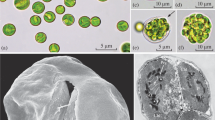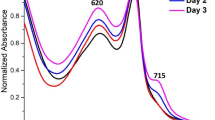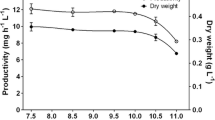Abstract
A new chemically mutagenic mutant ofSynechococcus PCC7942 named high-CO2 requiring mutant, which could grow at 4% CO2 but could not grow at air levels of CO2, was isolated. Comparative studies on some physiological aspects of the mutant and high-CO2 growing cells (growing at 4% CO2) were conducted. The result showed that the mutant had lower growing rate, about 1/40th photosynthetic affinity to inorganic carbon, 25% lower carbonic anhydrase (CA) activity, lower quenching rate of chlorophyll fluorescence, and about 1/2 alkalinization rate of the medium. The CA activity responses of the two types of cells to different concentration of CO2 were determined. Upon the addition, of inorganic carbon (Ci), the rate of active Ci uptake described by the rate of chlorophyll fluorescence quenching of the mutant was obviously lower compared with that of the high-CO2 growing cells; the size of the internal inorganic carbon pool size detemined by the extent of fluorescence quenching of the mutant was also smaller.
Similar content being viewed by others
References
Badger, M. R., 1987. The CO2 concentrating mechanism in aquatic phototrophs. The Biochemisty, of Plants: A comprehensive treatise. Photosynthesis. Hatch, M. D., Boardman, N. K. (eds). Academic Press,10: 219–219
Cook, C. M., Lanaras, T., Roubelakis-Angelakis, K. A., 1988. Bicarbonate transport and alkalization of the medium by four species of Rhodophyta.J. Exp. Bot.39: 1185–1198.
Friedberg K., Kaplan, A, Ariel, R. et al., 1989. The 5′ flanking region of the gene encoding the large subunit of ribulose-1, 5-bisphosphate carboxylase/oxygenase is crucial for growth of the cyanobacteriumSynechococcus PCC7942 in air level of CO2.J Bacteriol 171: 6069–6076.
Kaplan, A., Badger, MR, Berry, JA., 1980. Photosynthesis and intracellular inorganic carbon pool in the blue green algaeAnabaena variabilis: response to external CO2 concentration.Planta 149: 219–226.
Kaplan, A., Schwarz, R., Ariel, R. et al., 1990. The CO2-concentrating mechanism of cyanobacteria: physiological molecular and theoretical studies.Bot. Mag. Tokyo Spec. Iss. 2: 53–71.
Lucas, W.J., 1983. Photosynthetic assimilation of exogenous HCO3 − by aquatic plants.Annu. Rev. Plant Physiol. 34: 71–104.
Marcus, Y., Friedberg, D., Kaplan, A., 1986. High-CO2 requiring mutant ofAnacystis nidulans R2.Plant Physiol.82: 610–612.
Mayo, M. P., Elrifi, I. R., Tur**, D. H., 1989. The relationship between ribulose bisphosphate concentrations dissolved inorganic carbon (DIC) transport and DIC-limited photosynthesis in the cyanbacteriumSynechococcus leopoliensis grown at different concentrations of inorganic carbon.Plant Physio.190: 720–727
Michal Ronen-Tarazi, Judy Lieman-Hurwitz, Chana Gabay et al., 1995. The genomic region ofrbc LS inSynechococcus sp. PCC7942 contains genes involved in the ability to grow under low CO2 concentration and in chlorophyll biosynthesis.Plant Physiol.108: 1461–1469.
Miller, A. G., Canvin, D. T., 1987. The quenching of chlorophyll a fluorescence as a consequence of the transport of inorganic carbon by the cyanobacteriumSynechococcus UTEX625.Biochem. Biophys. Acta 894: 407–413.
Miller, A. G., Espie, G. S., Canvin, D. T., 1988. Chlorophyll a fluorescence yield as a monitor of both active CO2 and HCO3 − transport in the cyanbacteriumSynechooccus UTEX625.Plant Physiol.86: 655–658.
Miller, A. G., Espie, G. S., Canvin, D. T., 1991. The effects of inorganic carbon and oxygen upon fluoresce in the cyanobacteriumSynechococcus UTEX625.Can. J. Bot. 69: 1151–1160.
Ogawa, T., Kaneda, T., Omata, T., 1987. A mutant ofSynechococcus PCC7942 incapable, of adaptation to low CO2 concentration.Plant Physiol.84: 711–715.
Price, G. D., Badger, M. R., 1989a. Isolation and characterization of high-CO2-requiring mutants of the cyanobacteriumSynechococcus PCC 7942: Two phenotypes that accumulate inorganic carbon but are unable to generate CO2 within the carboxysome.Plant Physiol.91: 514–525.
Price, G. D., Bandger, M. R., 1989b. Expression of human carbonic anhydrase in the cyanobacteriumSynechococcus PCC7942 creates a high-CO2 requiring phenotype.Plant Physiol.91: 514–525.
Price, G. D., Coleman, J. R., Badger, M. R., 1992. Association of carbonic anhydrase activity with carboxysomes isolated from the cyanobacteriumSynechococcus PCC7942.Plant Physiol.100: 784–793.
Schwarz, R., Lieman-Hurwitz, J., Hassidem, M. et al. 1992. Phenotypic complementation of high-CO2 requiring mutants of the cyanobacteriumSynechococcus sp. strain PCC7942 by inosine 5′-monophosphate.Plant Physiol.100: 1987–1993.
Turpin, D. H., Miller, A. G., Canvin, D. T., 1984. Carboxysome content ofSynechococcus leopoliensis (Cyanophyta) in response to inorganic carbon.J. Phycol. 20: 249–253.
Wilbur, K. M., Anderson, N. G., 1948. Electrometric and colorimetric determination of carbonic anhydrase.J. Bio. Chem. 176: 147–154.
Author information
Authors and Affiliations
Rights and permissions
About this article
Cite this article
Tian-fu, W., Li-rong, S. & Yong-ding, L. Physiological aspects of a high-co2 requiring mutant and the high-co2 growing cells of the cyanobacteriumSynechococcus pcc7942. Chin. J. Ocean. Limnol. 16 (Suppl 1), 133–139 (1998). https://doi.org/10.1007/BF02849091
Issue Date:
DOI: https://doi.org/10.1007/BF02849091




